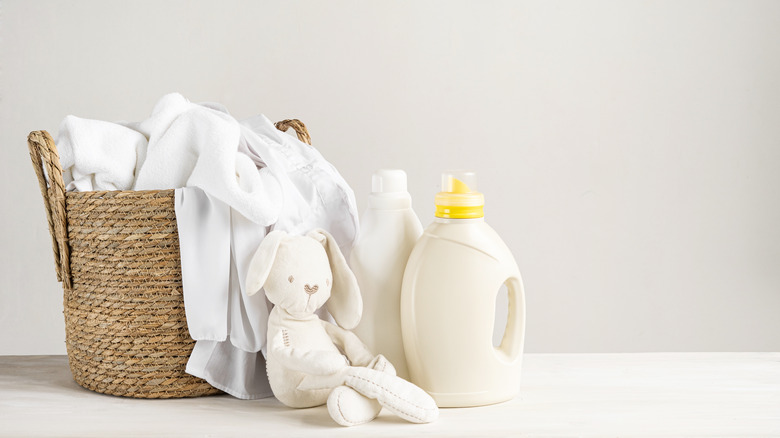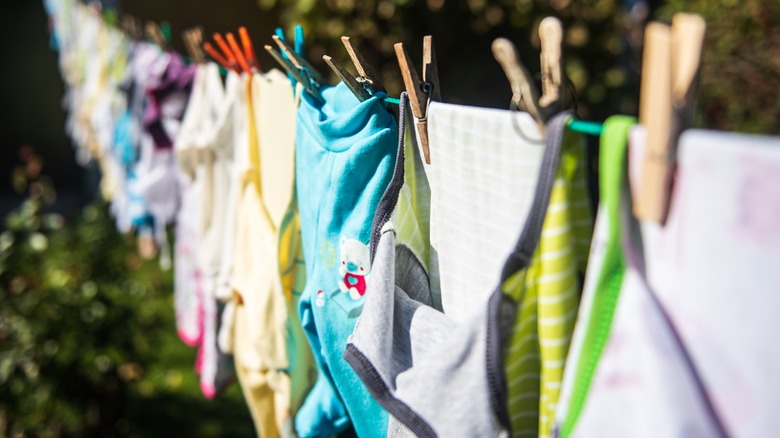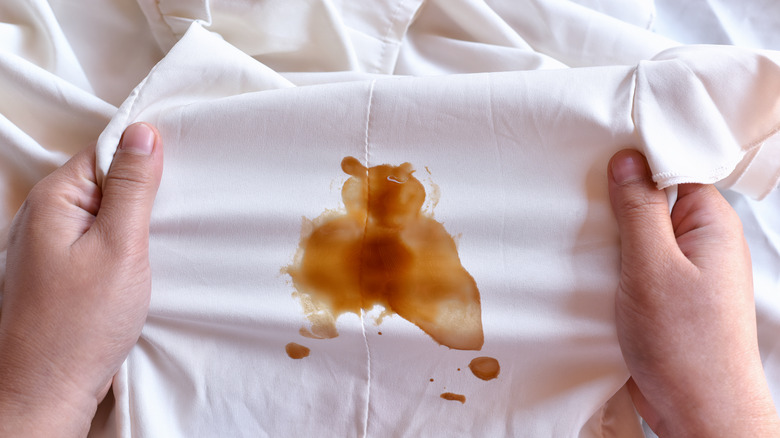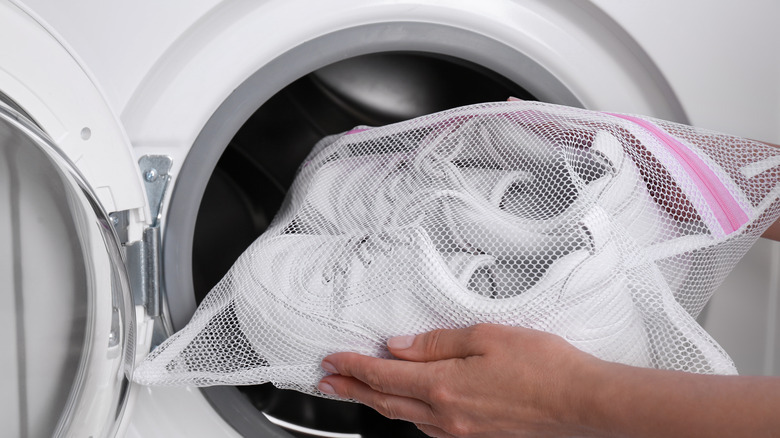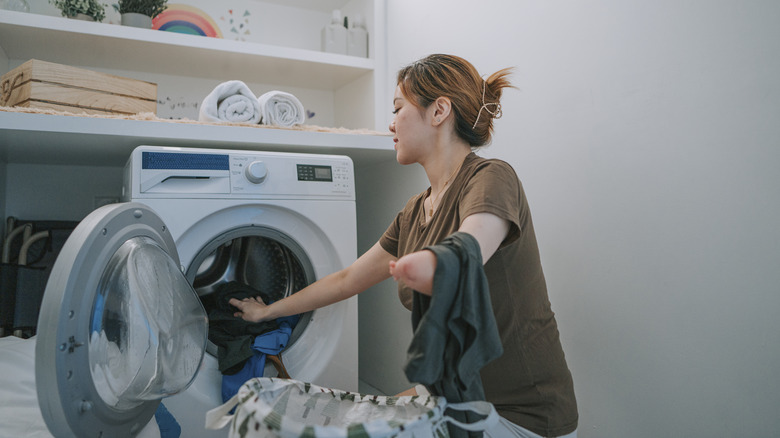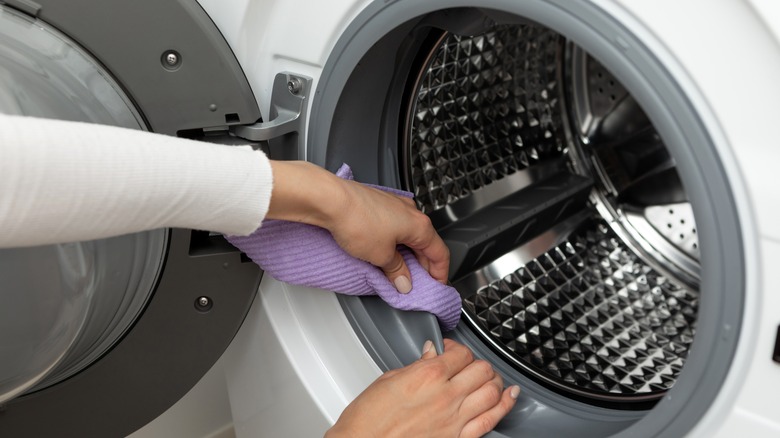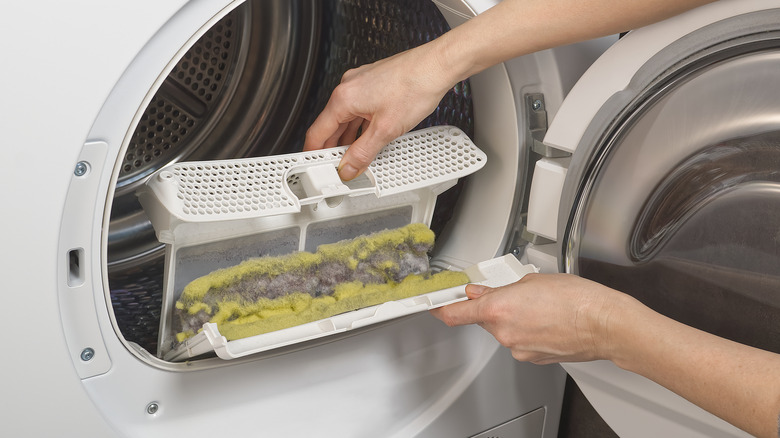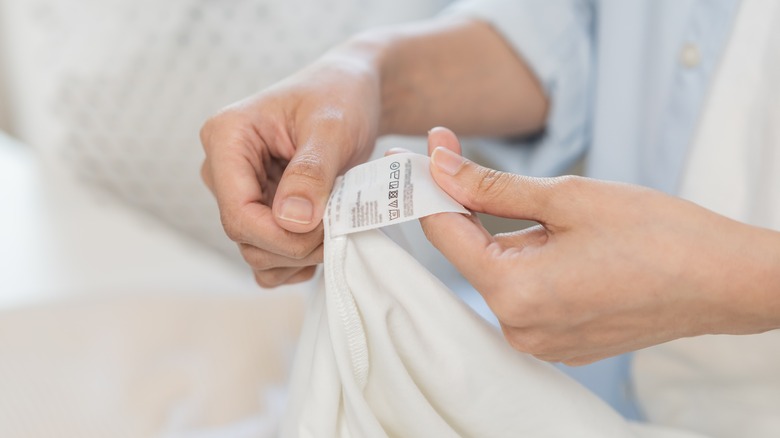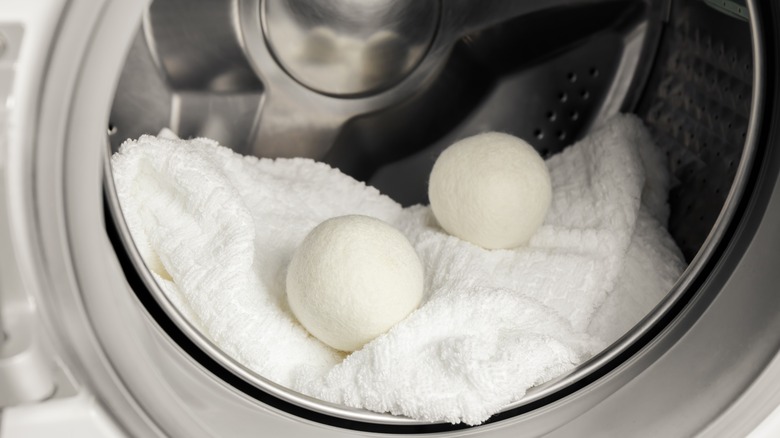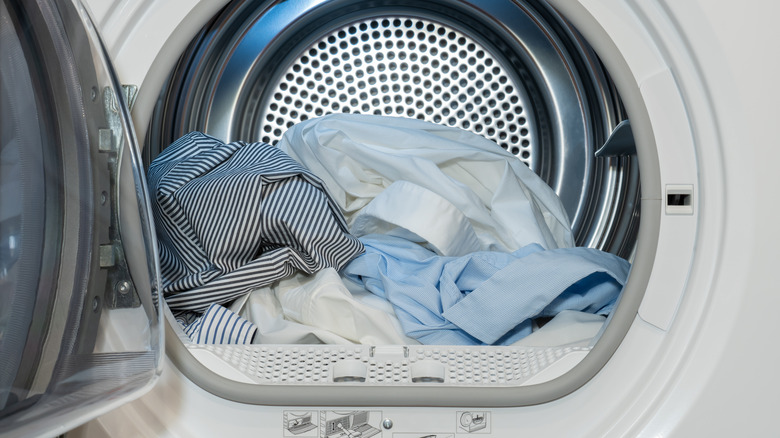12 Laundry Mistakes That Are Surprisingly Easy To Fix
Are you guilty of using excess detergent? Do you not have enough time to separate your darks from your lights? Or maybe that one t-shirt from college turned everything pink? We get it. Laundry comes with its own precarious challenges. Depending on water pressure, brand of washing machine, detergent brand, volume of laundry, and water temperature -– laundry can be a deceptively complicated and time-consuming endeavor when not thought through.
Complications from laundry can disrupt the functionality and serenity of a home and prevent you from feeling your best. Medium notes that the main issue is that many homeowners are busy trying to do too many things at once to effectively complete their laundry without any problems. But have no fear; we are here with solutions to help you combat some of the more common problems that homeowners face when managing their laundry. So let's pause the folding, turn off the TV, and dive in!
Using the wrong amount of detergent
A laundry repair technician that comes by will likely tell you that you are using too much detergent. Fun fact: the doses that laundry detergent caps recommend are often excessive and shouldn't always be taken at face value (according to Organized Interiors). First of all, it can cause excess suds, build up, leaking, and potentially damage your home's flooring. If your washing machine is in the garage, this is a concern of which to always be mindful.
Leaking suds in a garage could potentially damage electrical wiring around the washing machine, as well as other functions within the garage, and even present a fire hazard. Excess soap can also affect the quality of the clean. Extra bacteria and residue can often be found on overly washed clothing. This is due to the fact that excess soap will not allow the washing machine to drain as effectively as it could. Next time you wash your clothing, perhaps experiment with using 75% of the detergent you would normally use.
Using wrong temps and over-washing
The gut instinct of most people is that a hot wash and hot dry are the best combo for stain removal and an optimal clean. Unfortunately, this is not the case. Fabric fibers tear more easily, and most stains actually worsen under hot water (according to Blanc Living). Instead, wash your clothing as cold as possible. Not only will they last longer, but they will look newer longer. In an ideal circumstance, avoid machine drying your clothes. Though time-consuming, drying laundry on a clothesline is the surefire way to keep your clothes looking fresh and unwrinkled for a long time. But if that setup is not an option, always dry your clothes on low heat.
And as it pertains to washing, you are likely washing your clothes a bit more frequently than necessary. Thicker items like jeans and heavier shirts often do not warrant a full machine wash after one use. Blanc Living suggests using a scented antibacterial spray to keep them smelling and feeling fresh instead.
Treating all stains the same
Every stain is its own unique problem with individual cleaning requirements. We are going to break down the easy solutions for removing various types of stains. For coffee, a combination of heated water, dish wash, and white vinegar will do. Spot clean, don't scrub. Wine, on the other hand, warrants a completely different solution. Combine a half-and-half mixture of hydrogen peroxide and blue dish soap, and you should be able to remove that pesky red splotch. However, oil and grease stains come with their own rules. Time is of the essence. You want to use a solid substance like baking soda or cornstarch and spot treat right away (as noted by Reader's Digest).
With all of these stain treatments, they are typically best treated without the use of a washing machine. Spot treatment is best-utilized immediately and before the stain dries. Always use cold water. Never scrub, as that can strain the clothing fibers. The stain may also require multiple rounds of treatment, so patience is key here.
Not taking time for preparations
Plenty of homeowners set aside time for folding and storing laundry after the rinse and dry cycles. But the preparation before the wash is equally important, and a step that too many people neglect. This can have disastrous effects on clothing. When preparing laundry for a wash, make sure that all zippers are closed. The teeth can slice up and cause unnecessary damage to the other clothes. Contrarily, it is also important to unbutton all clothing prior to washing. Keeping them buttoned can lead to the buttons breaking off earlier than they should. In the interest of your clothes' longevity, this is of vital importance.
Aside from preparing your main pieces, it is also important to make sure socks are accounted for. We tend to chuck them in last as an afterthought. But actually, there is a hack to making this process less stressful. Real Simple suggests using a large laundry bag for all of your socks so that you can keep track of them without any issue. This is an excellent organizational tool for your laundry, and almost a second hamper that will streamline this process with ease.
Overloading the washer
Overloading the washing machine is another common mistake people make when doing laundry. You may assume that as long as you can get your clothing or linens to fit inside the drum while still being able to close the door, it's good enough. However, this simply isn't the case. If the clothes are too tightly packed in the machine, there will not be sufficient space for water to move around between the various items. This will limit the washer's ability to effectively clean your clothing. Overfilling your washer on a regular basis may also lead to more costly repairs or even earlier replacement. Loads that are too heavy can place too much strain on the various mechanical components, which could lead to them failing sooner than they would have otherwise.
Never fill the drum of your washing machine more than three-quarters full. If you have a top-loading washer, this means that no clothing or linens should be above the top of the agitator. For front-load machines, make sure that your stack of garments or other items doesn't go higher than the final row of holes along the front of the machine.
Not cleaning your washer
As your washing machine cleans your clothes, it also keeps itself clean, right? Unfortunately, if you've been operating under this philosophy of thinking, you've been making a mistake. Washing machines that are not cleaned on a regular basis offer the ideal breeding ground for bacteria. Even though water is moving through the machine as it cleans clothing and linens, bacteria can build up on the walls of the drum. These bacteria can come from residues left behind by detergents, fabric softeners, and other cleaners, food, pet hair, and more. Dirty washers can leave behind an unpleasant odor on "clean" clothes.
Aim to run an empty wash or rinse cycle at least once a week to remove excess buildup. Then, once a month, give the washer a deep cleaning. You can purchase special washing machine cleaning tablets online or at the store, or you can make a DIY washing machine cleaner using baking soda and vinegar. Add the baking soda and vinegar to the washing machine, and select the cleaning cycle. If your model does not have a cleaning cycle, choose the longest and hottest wash cycle instead. After the cycle finishes, use a microfiber towel or scrub brush to wipe everything down and remove any remaining residue.
In addition to cleaning the washer itself, be sure to also clean any bleach or detergent trays or other removable components. Many of these can be soaked in vinegar and wiped down. Don't forget to also wipe down the top and front of the machine using a microfiber cloth. Once cleaned, leave the door open for a few hours to give everything a chance to dry.
Not cleaning your dryer
Just as you need to clean your washer regularly, it is also important to make sure that you are not neglecting the dryer. When cleaning the dryer, there are actually several different components that will need to be addressed. One of these is making sure that lint is removed from both the dryer itself and the dryer vent. You likely empty the lint screen after each load. However, lint is still able to get into the machine and the vent from the machine to the outdoors. If too much lint accumulates, it increases the risk of a fire breaking out.
The first step to getting excess lint out of the machine is to take out the lint screen. Use the crevice attachment for your vacuum cleaner to vacuum up the lint stuck under the screen. Next, replace the lint screen and unplug the dryer. Pull the machine out from the wall enough to remove the dryer vent from its rear. Use your hands and a vacuum attachment to clear out the lint from the hose. Find the exterior vent and remove any trapped lint from it as well. Once the vent has been thoroughly cleaned, reattach it to the dryer and turn the dryer on (while empty) for about 15 minutes to help clear any lint or dust that remains. If your dryer vent hose is very long, or you are just not comfortable cleaning it yourself, you can hire a professional to take care of it for you. Aim to clean the vent about once every year.
Finally, use a damp microfiber cloth to wipe down the inside and outside of the unit. Toss in some clean and dry towels and turn the dryer on for a few minutes to remove any excess water from the drum. Make it part of your routine to wipe out your dryer every time you clean the washer.
Ignoring clothing labels
Not all of your clothing items should be washed in the same way. It is essential to read the care label attached to each garment before simply tossing them into the washing machine or the dryer. Some garments should only be washed using cold water, while others will tolerate warm or even hot water. Labels may also specify whether a mild or liquid detergent is required when washing a given garment. Some of the other important information you can learn by reading a care label is whether the item can be dried in the dryer, the ideal dryer temperature setting, if it should only be hand-washed, if you can use bleach when washing it, whether you can iron it after drying to remove wrinkles, and more.
Failing to read the care label can have serious consequences. When you don't follow the manufacturer's cleaning recommendations, you're risking damaging or even completely ruining the item. The colors could fade, the fabrics could stretch, tear, or pill, or the item could shrink. These may amount to very costly mistakes that could be avoided by just taking a few minutes to read (and then follow) the manufacturer's laundry codes and recommendations.
Using dryer sheets instead of dryer balls
Adding dryer sheets to each load of laundry can help reduce static cling, soften your clothes, and leave each load smelling fresh. However, did you know that there are several cons that are also associated with the use of dryer sheets? They are formulated with various chemicals that can also irritate your skin. Moreover, because they are disposable, you're also contributing to already overflowing landfills.
Fortunately, there is an alternative product that can deliver many of the same benefits as dryer sheets without the negative cons. Adding a few dryer balls — or even clean tennis balls — to each load of laundry can help increase air circulation in the dryer. This means that your clothes will dry more quickly. Unlike dryer sheets, they are made using safe and natural ingredients that won't threaten your health or irritate your skin.
Dryer balls are also reusable, making them better for your bank account and the planet. If you like using dryer sheets because of the scent they leave behind on your clothes, you can achieve the same result by adding a few drops of an essential oil of your choice to each dryer ball before starting the load of laundry.
Not sorting clothes before washing them
When you do laundry, do you sort your clothes before putting them in the washer? If you have just been tossing everything in together, then you've just identified another mistake you've been making. There are several reasons to sort your items. One ties back to something we discussed earlier: reading the care label. If you mix items that require different water temperatures, washer settings, or dryer settings together in the same load, then you're running the risk of damaging — or ruining — the fabrics.
Beyond sorting clothing by care instructions, it is also important to sort it by color. If you wash your whites with darker items, they will not look as bright or clean after several cycles. It is also possible that the dyes from a darker item, like a red shirt, will transfer to your whites and turn them pink. After you've sorted by color and wash instructions, take one last look at each pile. Make sure to further separate lighter weight and heavier weight items. A bulky pair of jeans, for example, can rub against your more delicate fabrics and damage them. Moreover, that pair of jeans is going to take a lot longer to dry than a lightweight T-shirt. Excessive time in the dryer can also have a negative effect on your fabrics.
Forgetting about clothes and leaving them in the washer or dryer for too long
Leaving your laundry in either the washer or dryer for too long is not a good idea. With the moisture in these machines, it is possible for mold or mildew to start to grow if they are left in the closed-in space for too long. In addition to the potential health concerns associated with mold or mildew, their presence can also make your clothes smell. Try not to leave wet items in the washer or dryer for longer than overnight — any longer than this, and you're increasing the likelihood that mold or mildew will grow.
Leaving your dried clothes in the dryer can present another possible problem. As the dry clothes sit in the machine, more wrinkles will develop, making it necessary to iron them or waste more energy by running a second dryer cycle. If you tend to forget about a load of laundry in the washer or dryer, try setting a time for yourself. The reminder to switch the loads or remove them from the dryer may be all you need to keep your clothes wrinkle-free and prevent mold or mildew from growing on them.
Tossing new clothing items in with your regular laundry
Whenever you buy new clothes, you should always wash them in a separate cycle from your normal laundry. One reason this is necessary is that many new items are not pre-washed, so all of the dyes in the fabrics are not fully set in. When you clean them, some of the dyes will wash out. If you have other items in the washer, these dyes could transfer to them and change their color.
Fabrics are often treated with various chemicals during the production process. New clothes may still have some of these chemical residues on them. Washing them separately from your other laundry will prevent the transfer of the chemicals to your existing items. Keeping your new laundry separated from your old clothes is also a good idea if you want to keep the clothes looking newer for longer. As the more worn-out fabrics rub against the newer fabrics, they're more likely to cause pilling or wear. The dirt and oils on your dirty laundry can also have a negative impact on the new clothes and can make them look dull or faded.

